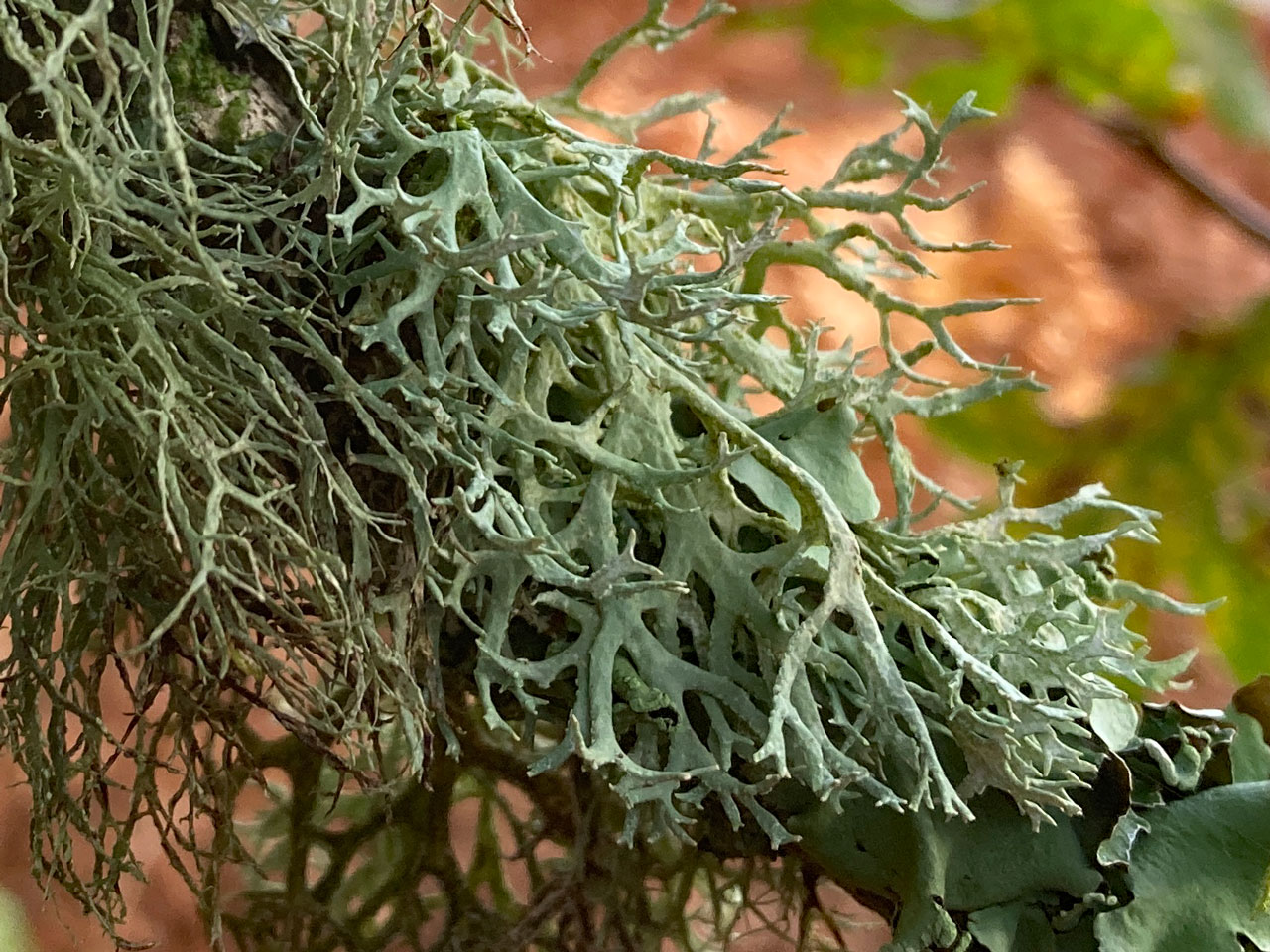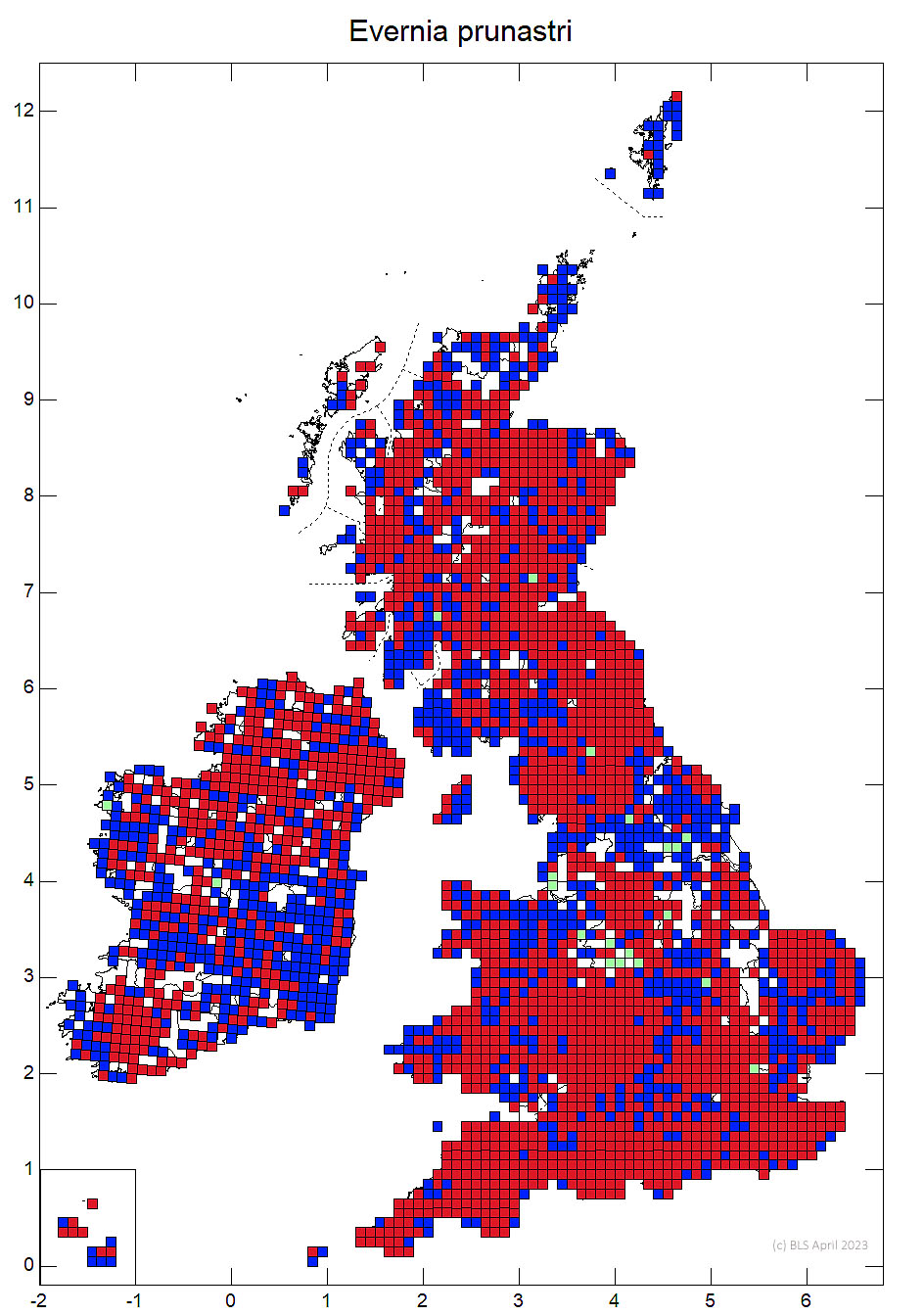A common lichen forming bushy thalli of strap-shaped lobes, with soredia becoming frequent on the upper surface. Distinct for similar lichens in the upper surface being green-grey to yellow grey and the lower surface mostly white. It can be confused with Ramalina farinacea which is not white on the underside or Pseudevernia furfuracea which has a sliver-grey upper side, often with isidia and a lower side that becomes dark grey to black. Widespread and often abundant with a wide ecological amplitude, principally found on on sunny, often exposed, neutral to acid barked trunks or twigs.
Thallus (1–) 2–6 (–10) cm long, 2–4 (–6) mm broad, about 1 mm thick, foliose; lobes rather soft, numerous, strap-shaped, ± palmately branched, often twisted and pendulous; upper surface green-grey to pale green-yellow, often with an incomplete network of elongate ridges spreading towards the margins and delimiting hollows; lower surface white, almost lacking photobiont but occasionally dotted green especially towards the tips; soralia marginal and/or laminal, at first rounded and often confined to eroded surfaces of ridges and/or lobe margins, later becoming confluent, paler or concolorous with the upper surface. Apothecia rare in Britain, 2–5 mm diam. Ascospores 7–11 x 4–6 μm. Pycnidia ca 0.3 mm diam.; conidia 6–7 × ca 0.5 μm. Medulla C–, K–, KC–, Pd–, UV– (usnic and evernic acids, atranorin).
The ‘oak moss’ of the perfume industry. Material from shaded habitats usually has fewer, paler, often more elongate lobes. Specimens from polluted sites are often reduced in size with contorted or downturned lobes which can be markedly eroded and sorediate. Here they can be confused with Ramalina farinacea which has a cartilaginous cortex and twisted, rope-like structure. A grey race, deficient in usnic acid, has been called E. prunastri f. herinii (Duvign.) D. Hawksw. (1980), and can grow with the yellow-green f. prunastri, where it retains its identity. The presence of both atranorin and usnic acid is demonstrated on TLC plates by the purple coloration produced on charring where the spots of the two substances overlap.
Sometimes confused with Pseudevernia furfuracea which has a grey upper side, often with isidia and a lower side that becomes dark grey to black in the older parts.
See also Fungi of Great Britain and Ireland & Species Description PDF
Widespread and often abundant with a wide ecological amplitude, principally on sunny, often windswept, neutral to acid barked trunks or the canopy of wayside and parkland trees and in hedgerows; also on fence-posts, old stems of Calluna or on the ground on heathland and dunes, more rarely in sheltered woodland and boggy sites; sometimes on nutrient-rich siliceous rocks, gravestones, stabilised shingle, short turf and brick walls.

Throughout Britain and Ireland. It returned rapidly since 1980 to the English Midlands and urban areas as SO2 levels declined, and is now almost ubiquitous, but sensitive to high levels of ammonia pollution.
An acidophile lichen and sensitive to ammonia pollution
Cannon, P., Divakar, P., Yahr, R., Aptroot, A., Clerc, P., Coppins, B., Fryday, A., Sanderson, N. & Simkin, J. (2023). Lecanorales: Parmeliaceae, including the genera Alectoria, Allantoparmelia, Arctoparmelia, Brodoa, Bryoria, Cetraria, Cetrariella, Cetrelia, Cornicularia, Evernia, Flavocetraria, Flavoparmelia, Hypogymnia, Hypotrachyna, Imshaugia, Melanelia, Melanelixia, Melanohalea, Menegazzia, Montanelia, Nesolechia, Parmelia, Parmelina, Parmeliopsis, Parmotrema, Platismatia, Pleurosticta, Protoparmelia, Pseudephebe, Pseudevernia, Punctelia, Raesaenenia, Tuckermannopsis, Usnea, Vulpicida and Xanthoparmelia. Revisions of British and Irish Lichens 33: 1-98.
Text by N A Sanderson, based on Cannon et al (2023).



